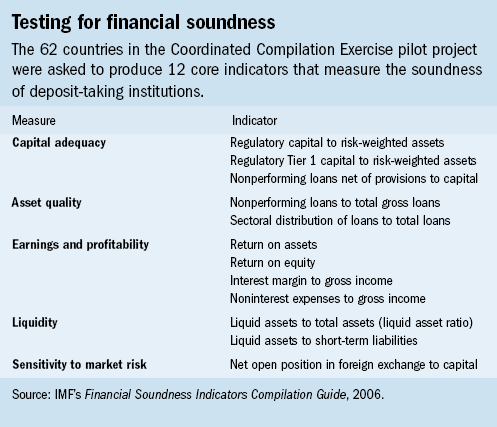
Typical street scene in Santa Ana, El Salvador. (Photo: iStock)
IMF Survey: IMF's Big Step on Financial Benchmarks
February 12, 2007
- Paucity of data available to gauge the well-being of financial systems became apparent
- Project participants produced 12 soundness indicators for deposit-taking institutions
- Another 28 indicators also covered nonbank financial institutions
The IMF has published standardized indicators designed to allow analysts to assess the soundness of a country's banking sector and compare it with those of other countries.

IMF Deputy Managing Director Murilo Portugal, with IMF Statistics Department staff, hails financial soundness indicators (Eugene Salazar/IMF)
BANKING SECTOR SOUNDNESS
In all, 62 countries judged to be of importance to the global economic system participated in the pilot project, which has its roots in the financial crises of the late 1990s. Data for 40 of the countries are on the IMF's website and information for most of the remaining 22 will be posted shortly. The pilot project is called the Coordinated Compilation Exercise for Financial Soundness Indicators.
Rob Edwards, Director of the IMF's Statistics Department, called the dissemination of the financial soundness indicators "a major step" in the IMF's efforts, as part of its medium-term strategy, "to strengthen the surveillance of member countries' financial systems, increase data transparency, and promote cross-country comparable data."
The IMF Executive Board plans to evaluate the exercise this autumn and determine whether to go forward with a permanent effort to disseminate financial soundness indicators. The pilot project asked all 62 participants to produce a dozen soundness indicators for deposit-taking institutions (mainly commercial banks) that measure, for these institutions as a whole, capital adequacy, asset quality, earnings and profitability, liquidity, and sensitivity to market risk (see box). The countries were also encouraged to produce another 28 indicators that not only provided additional information on the banking sector but also covered nonbank financial institutions (such as insurance companies and pension funds), financial sector customers (such as corporations and households), and the real estate and securities markets.
After the financial crises in Latin America, Russia, and especially Asia a decade ago, the paucity of data available to gauge the well-being of financial systems became apparent, according to Armida San Jose, a Division Chief in the Statistics Department, which shepherded the project. In many cases there was no available information or countries did not make the data public, she said. And among countries that did make public the data, they were often not comparable.
Response to crises
The IMF held a brainstorming conference in 1999 that brought together, among others, central bankers and bank regulators, private financial institutions, representatives of international organizations, credit rating agencies, and academics to think through whether a set of financial soundness indicators was needed and, if so, what to produce and how to do it. That conference set off a chain of events that led to the IMF's production of a guide to compiling financial soundness indicators and the decision to conduct the pilot project using that Compilation Guide as its base. San Jose said that the pilot exercise is an innovative approach in the way IMF staff and country officials work together and learn from each other to produce a new form of aggregate statistics.
San Jose also said that for a variety of reasons, not all statistics produced under the pilot exercise are fully in line with the recommendations in the Compilation Guide. But if a statistic is not fully consistent, that is noted in the so-called metadata (information about the data) that are published along with the data.








